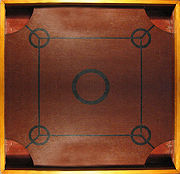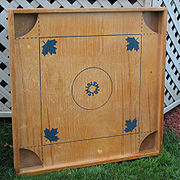
Pichenotte
Encyclopedia

French Canadian
French Canadian or Francophone Canadian, , generally refers to the descendents of French colonists who arrived in New France in the 17th and 18th centuries...
tabletop game
Tabletop game
Tabletop game is a general term used to refer to board games, card games, dice games, miniatures wargames, tile-based games and other games that are normally played on a table or other flat surface...
, with a board, game pieces and rules similar to carrom
Carrom
Carrom is a family of tabletop games with gameplay that lies somewhere between billiards and table shuffleboard. Carrom is known by many names around the world, including carrum, couronne, carum, karam, karom, karum, fatta and finger billiards...
. Used more broadly, the term is a general name for tabletop games played with small (usually wooden) pieces that are flicked using the thumb and index (or middle) finger, including such games as carrom, sharing a similarity in that their mechanics lie somewhere between pocket billiards
Pocket billiards
Pool, also more formally known as pocket billiards or pool billiards , is the family of cue sports and games played on a pool table having six receptacles called pockets along the , into which balls are deposited as the main goal of play. Popular versions include eight-ball and nine-ball...
and shuffleboard
Shuffleboard
Shuffleboard, more precisely deck shuffleboard, and also known as shuffle-board, shovelboard, shovel-board and shove-board [archaic], is a game in which players use broom-shaped paddles to push weighted pucks, sending them gliding down a narrow and elongated court, with the purpose of...
. The term is sometimes also mistakenly used as the actual name of other games of this class, such as carrom and crokinole
Crokinole
Crokinole is an action board game similar in various ways to pitchnut, carrom, marbles, and shove ha'penny, with elements of shuffleboard and curling reduced to table-top size...
. Commercially-produced boards are available, some under the trade name Pinnochi. The game is sometimes referred to as "piche" or "pish".
Origins
In Canadian French, the flicking action used in the game is called a "pichenotte" (standard French "pichenette"), from which the game name is derived. While the specifics are uncertain, pichenotte certainly must have originated from the Indian game carrom. In the mid-19th century, carrom was likely brought to CanadaCanada
Canada is a North American country consisting of ten provinces and three territories. Located in the northern part of the continent, it extends from the Atlantic Ocean in the east to the Pacific Ocean in the west, and northward into the Arctic Ocean...
by Indian or British immigrants.
Equipment

Rules
The aim of the game is to sink one's eleven pieces before the opponent sinks theirs. However before sinking one's final piece, the queen must be pocketed and "covered" by pocketing one of one's own pieces on the same or a subsequent shot. Fouls, such as crossing the diagonal lines on the board with any part of one's body, or (pocketing the striker or sending it off the board), lead to one of one's pieces being returned to the board.Variations
Another variant of the game called pitchnutPitchnut
Pitchnut is a wooden tabletop game of French Canadian origins, similar to carrom and pichenotte, with mechanics that lie somewhere between pocket billiards and air hockey. There are no records of the game being mass-produced. All existing boards are handmade and frequently handed down from...
has four screws or pegs 4 inches (10 cm) from the centre of the board, and two screws or pegs in front of each pocket. It also has 2-inch (5-cm) recessed alleys along each side.
External links
- Quebec Pichenotte Players Association - About Quebec Pichenotte Players Association -> contains rules, events, news

